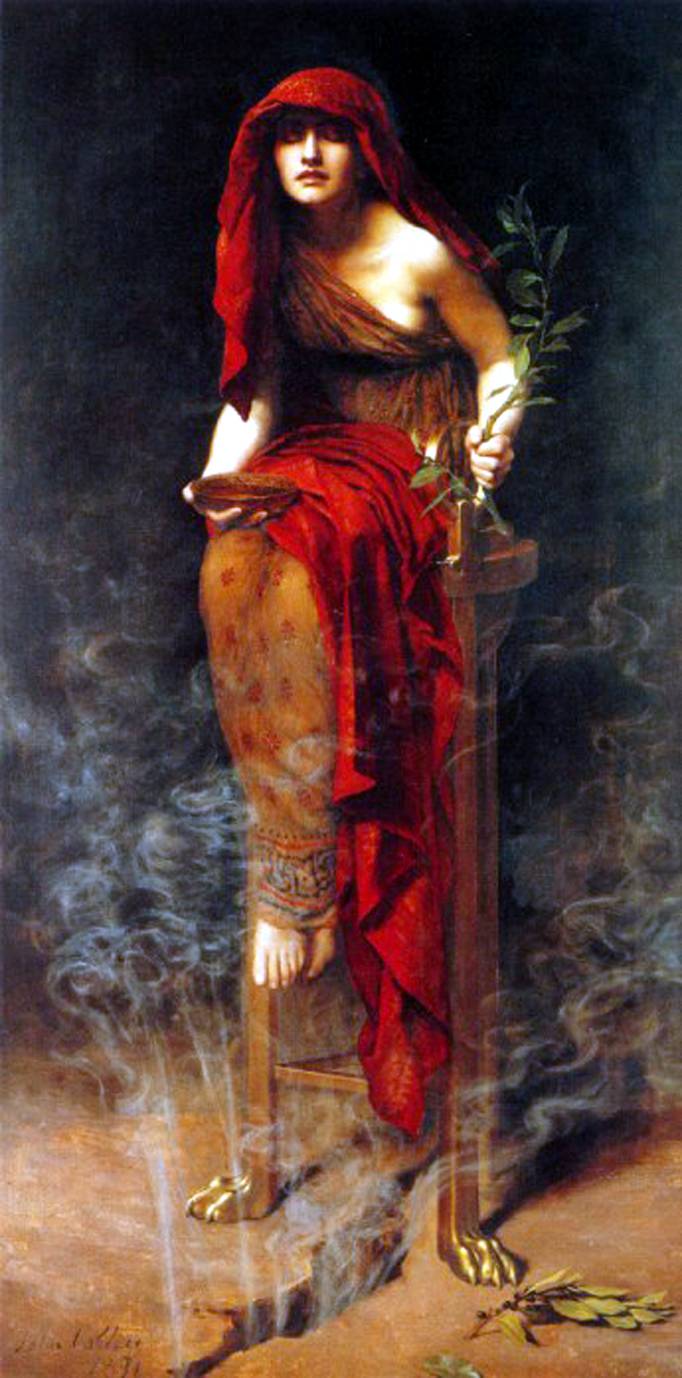Happy 4/20! For millennia, witches have been getting high to access the spirit realm and/or have orgies with the devil.
For most people, the most quintessential image
of a witch is a figure in silhouette, perched on a broomstick and flying
in front of the moon. I don't know about you, but the closest I've ever
come to feeling like I'm flying across the moon has been when I'm
stoned out of my mind.
One of the oldest, and most notable, examples of using altered states in magic is the Oracle of Delphi: For centuries, ancient priestesses of the Greek god Apollo, stationed at a temple built around a sacred spring at Delphi, would divine the future for visitors from all over the ancient world; so significant was their influence that kings would consult with them about whether they should go to war. It was generally understood that Apollo's spirit would enter each priestess, enabling her to see the future.
According to Uses and Abuses of Plant Derived Smoke, an ethnobotanical compendium on the use of smoke throughout the world, the priestess would sit on a tripod above a hole through which vapors arose, and these vapors were thought to induce her visions.
Though many researchers believe the vapors contained "a variety of potentially toxic natural gases" emanating from the ground, some hypothesize that hallucinogenic plants were burned beneath the temple and vented up towards the smoke-shrouded seer, or that the priestesses would smoke or eat hallucinogens in addition to inhaling the fumes from the earth. While many scholars theorize the Oracle burned bay leaves, since they were sacred to Apollo, others have taken it a step farther. Dr. DCA Hillman, a bacteriologist and classicist who has written about drug use in the ancient world, argues that there is evidence cannabis was traditionally burned to induce the Oracle's trance state since bay leaves are not known to have psychoactive properties, and marijuana was already introduced to Greece from central Asian tribes who knew of the herb's potent psychotropic powers.
The Oracle of Delphi was far from the only ancient magic practitioner to utilize marijuana in her craft: As noted in Uses and Abuses of Plant-Derived Smoke, "Members of the Gaddi tribe of India's Himachal Pradesh State in the western Himalayas, for example, smoked the resin of female [cannabis] plants, called sulpha, for the hallucinations it induced." Shamans and nobles from China to Russia have also been found buried with marijuana plants, denoting its sacred role.

The Oracle of Delphi. Image via Wikipedia Commons
It's likely that the use of these herbs in a ritual context points back to ancient cults like the Oracle of Delphi, and are one of the clearest links to witchcraft's primordial past. As witch, historian, and teacher at Colorado State University Chas Clifton writes in the famous essay If Witches No Longer Fly, "I would argue that the danger of these recipes, combined with the centuries-long tradition of their use, is the best argument for any 'Old Religion' surviving from pre- Christian times.
Without some sort of oral tradition of preparation and dosage, similar to that of the ayahuasca shamans of South America, the risks would be too great." The danger he cites is real: Modern witches and non-magical people alike have been sent to the hospital—or have even died, as in the case of the English witch Robert Cochrane—from taking too much belladonna and other witchcraft-related herbs.
Magical publishing in the last thirty years has been significantly hamstrung by the way psychedelics have been used as geopolitical footballs.So why is herbal magic—the use of weed, most notably, but also other hallucinogens—less prevalent in modern witchcraft? After all, the occult revival of the 19th century revolved around absinthe and opium dens, and the second big occult revival happened during the drug-crazed days of the 1960s and 70s. It seems like magic and getting high go pretty hand in hand.
One obvious answer is because marijuana is still illegal, even for medical use, in many states and countries. This makes it nearly impossible for occult book publishers to let authors recommend using weed as a method to achieve trance states and soul flight, even if that is their preferred method.
As Gordon White laments in The Chaos Protocols, "Magical publishing in the last thirty years has been significantly hamstrung by the way psychedelics have been used as geopolitical footballs. As an author, I cannot legally advocate a reader break any laws, and publishers can, in theory, be held liable for damages arising from actions taken as described in their books."
Still, modern witches are continuing to use marijuana in their practices, most often in solitary meditation or to help them access the spirit realm. Elizabeth DeCoursey, owner of Antidote
Apothecary and Tea Bar in Brooklyn, says she typically uses weed as a meditative aid. "When I want to thin the veil and access ancient knowledge and the collective consciousness of water, the total, deep, and cellular calm I can achieve with an edible in deep trance is pretty profound," she tells Broadly. There's a reason weed has historical ties to magic: Having a safe, reliable way to enter altered states of consciousness can be an amazing tool in witchcraft.


No comments:
Post a Comment